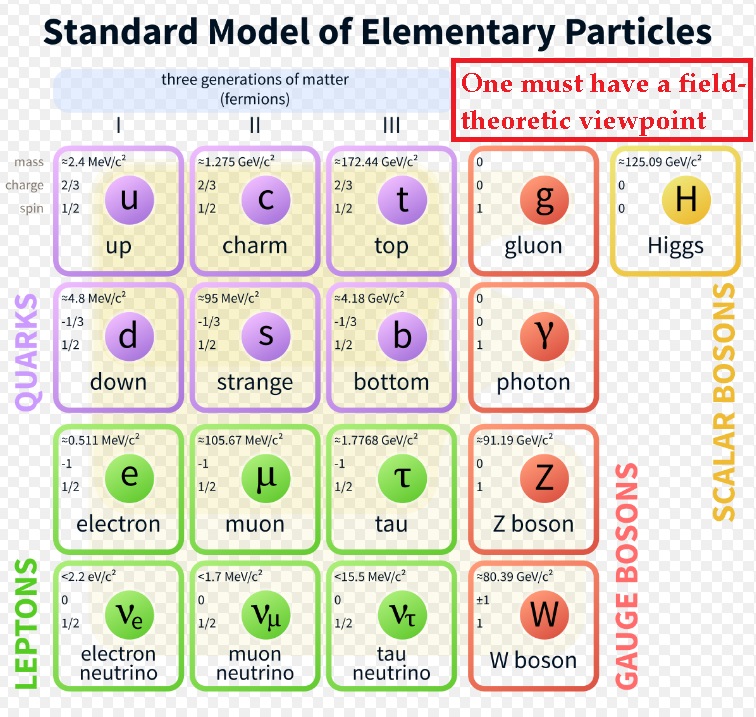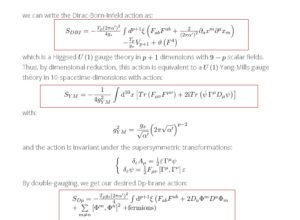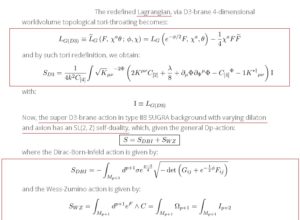In this post, the mathematics applies to both, Randall-Sundrum-1and-2 models, hence I will not distinguish between them here. One of the most powerful aspects of M-theory’s braneworld scenarios is that the bosonic and fermionic fields of the Standard Model of physics can be interpreted as low-lying Kaluza-Klein excitations of Randall-Sundrum bulk fields, after extra dimensional modulus stabilization, and recalling that Randall-Sundrum bulk/brane interactions yield a very deep solution to the EW hierarchy problem. Start with the theory defined by the following action:
![Rendered by QuickLaTeX.com \[S = \frac{1}{2}\int {{d^4}} x\int\limits_{ - \pi }^\pi {d\phi \sqrt G } \left( {{G^{AB}}{\partial _A}\Phi {\partial _B}\Phi - {m^2}{\phi ^2}} \right)\]](https://www.georgeshiber.com/wp-content/ql-cache/quicklatex.com-f832e307b49ef21b0c629ebc7a52b378_l3.png)
with the bulk field given by:
![]()
where generally, the bulk action, with worldsheet-uplift, is given by:
![Rendered by QuickLaTeX.com \[\begin{array}{l}{S_B} = - \frac{1}{{2{k^2}}}\int {{d^D}} X\left\{ {\frac{1}{2}} \right.\left[ {{\eta ^{\mu \rho }}} \right.{\eta ^{\nu \sigma }} + {\eta ^{\mu \sigma }}{\eta ^{\nu \rho }}\\ - \frac{2}{{D - 2}}{\eta ^{\mu \nu }}\left. {{\eta ^{\rho \sigma }}} \right]{h_{\mu \nu }}{\partial ^2}{h_{\rho \sigma }}\left. { + \frac{4}{{D - 2}}\bar \Phi {\partial ^2}\bar \Phi } \right\}\end{array}\]](https://www.georgeshiber.com/wp-content/ql-cache/quicklatex.com-5f0b85db9c91afc633f6f7cd041c275a_l3.png)
and ![]() satisfying:
satisfying:
![Rendered by QuickLaTeX.com \[\int\limits_{ - \pi }^\pi {d\phi {e^{ - \sigma \left( \phi \right)}}} {\Upsilon _n}\left( \phi \right){\Upsilon _m}\left( \phi \right) = {\delta _{nm}}\]](https://www.georgeshiber.com/wp-content/ql-cache/quicklatex.com-3d381f7572ecfb1c28f9799a38f4abb4_l3.png)
with a Dirac-Born-Infeld brane interaction term:
![]()
which, after integration by parts and upon substituting ![]() in our action, we get the Horava-Witten action variant:
in our action, we get the Horava-Witten action variant:
![Rendered by QuickLaTeX.com \[\begin{array}{c}S = \frac{1}{2}\int {{d^4}} x\int\limits_{ - \pi }^\pi {{r_c}d\phi } \left( {{e^{ - 2\sigma \left( \phi \right)}}} \right.\\{\eta _{\mu \nu }}{\partial _\mu }\Phi {\partial _\nu }\Phi + \frac{1}{{r_c^2}}\left( {{e^{ - 4\sigma \left( \phi \right)}}\partial \Phi } \right)\\ - {m^2}{e^{ - 4\sigma \left( \phi \right)}}\left. {{\Phi ^2}} \right)\end{array}\]](https://www.georgeshiber.com/wp-content/ql-cache/quicklatex.com-83659040610901121cebee2dc76865ed_l3.png)
Now, the bulk fields manifest themselves to 4-D ‘observers’ as infinite towers of scalars ![]() with masses
with masses ![]() . After change of variables to:
. After change of variables to:
![]()
our actions reduce to two interaction terms:
![Rendered by QuickLaTeX.com \[S_{{\mathop{\rm int}} }^G = \int {{d^4}} x\int\limits_{ - \pi }^\pi {d\phi \sqrt G } \frac{\lambda }{{{M^{5m - 5}}}}{\left( {{G^{AB}}{\partial _A}\Phi {\partial _B}\Phi } \right)^m}\]](https://www.georgeshiber.com/wp-content/ql-cache/quicklatex.com-8b5e546cb473c55dc67bf559edd9e08f_l3.png)
and:
![Rendered by QuickLaTeX.com \[\begin{array}{l}S_{{\mathop{\rm int}} }^\Upsilon = \int {{d^4}} x\int\limits_{ - \pi }^\pi {{r_c}} d\phi {e^{ - 4\sigma \left( \phi \right)}}\frac{\lambda }{{{M^{5m - 5}}}} \cdot \\\psi _n^{2m}\left( {\frac{{{{\left( {{\partial _\phi }{\Upsilon _n}} \right)}^2}}}{{r_c^3}}} \right)\end{array}\]](https://www.georgeshiber.com/wp-content/ql-cache/quicklatex.com-4962c2b1da95e3046629bcf43a27ac78_l3.png)
where we have:
![]()
and the Bessel functions of order:
![]()
yield the standard Bertotti-Robinson-solutions. Hence, we have:
![Rendered by QuickLaTeX.com \[\begin{array}{*{20}{l}}{{\Upsilon _n}\left( \phi \right) = \frac{{{e^{2\sigma \left( \phi \right)}}\phi }}{{{N_n}}}\left[ {{J_\nu }\left( {\frac{{{m_n}}}{k}{e^{\sigma \left( \phi \right)}}} \right)} \right. + }\\{\left. {{b_{n\nu }}{\Upsilon _\nu }\left( {\frac{{{m_n}}}{k}{e^{\sigma \left( \phi \right)}}} \right)} \right]}\end{array}\]](https://www.georgeshiber.com/wp-content/ql-cache/quicklatex.com-b6f7327a5581fb461a0442f099910a77_l3.png)
with a normalization factor. That the differential operator on the LHS of:
![]()
is self-adjoint means that the derivative of is continuous at the orbifold fixed points, giving us:
![Rendered by QuickLaTeX.com \[\left\{ {\begin{array}{*{20}{c}}{{N_n} \simeq \frac{{{e^{k{r_c}\pi }}}}{{\sqrt {k{r_c}} }}{A_n}}\\{{A_n} = {J_n}\left( {{x_{n\nu }}} \right)\sqrt {1 + \frac{{4 - {\nu ^2}}}{{x_{n\nu }^2}}} }\end{array}} \right.\]](https://www.georgeshiber.com/wp-content/ql-cache/quicklatex.com-103b6a814bf80ab10cb755615b5e0509_l3.png)
Four-dimensionally, these induce couplings between the Kaluza-Klein modes and so the exponential factor in:
![]()
where are Lorentz coordinates on the four-dimensional surfaces of constant
![]() thus plays an essential role in determining the effective scale of the couplings. If the Planck scale sets the scale of the five-dimensional couplings, the low-lying Kaluza-Klein modes will have TeV-range self-interactions.
thus plays an essential role in determining the effective scale of the couplings. If the Planck scale sets the scale of the five-dimensional couplings, the low-lying Kaluza-Klein modes will have TeV-range self-interactions.
Now, a Klebanov-Strassler geometry naturally arises by considering string theory compactification on ![]() where
where ![]() is the Einstein manifold in five dimensions, with the interaction-Lagrangian of the massless Klebanov-Strassler field and the brane fields fermions is:
is the Einstein manifold in five dimensions, with the interaction-Lagrangian of the massless Klebanov-Strassler field and the brane fields fermions is:
![Rendered by QuickLaTeX.com \[\begin{array}{*{20}{c}}{{\mathcal{L}^{KS}}_{\psi \bar \psi {H^0}}\frac{1}{{{M^{3/2}}}}\bar \psi \left[ {i{\gamma ^\mu }} \right.{\sigma ^{\mu \nu }}H_{\mu \nu \lambda }^0\left( {{x^\mu }} \right)}\\{\left. {\frac{{{\chi ^0}(r)}}{{\sqrt {\tau c} }}} \right]\psi }\end{array}\]](https://www.georgeshiber.com/wp-content/ql-cache/quicklatex.com-5a8770579b018be4ebb4b3daaa3c2dfd_l3.png)
which, after integrating over the extra dimensional part, the effective 4-D Lagrangian reduces to:
![Rendered by QuickLaTeX.com \[\begin{array}{*{20}{c}}{\mathcal{L}_{\psi \bar \psi {H^0}}^{KS} = i\bar \psi {\gamma ^\mu }{\sigma ^{\mu \nu }}\left[ {\frac{{{e^{ - 4\pi K/{3_{{g_s}}}M}}}}{{{M_{pl}}}}} \right. \cdot }\\{\left. {\left( {\frac{{{r_{\max }}}}{{{r_0}}}} \right)} \right]H_{\mu \nu \lambda }^0\psi }\end{array}\]](https://www.georgeshiber.com/wp-content/ql-cache/quicklatex.com-5d2a8b5b88e28b080e32a531f605ccef_l3.png)
with the fundamental Planck scale ![]() and the 4-D Planck scale
and the 4-D Planck scale ![]() related as
related as
![Rendered by QuickLaTeX.com \[{M_{pl}} = \frac{{{M^{3/2}}}}{{\sqrt {2R} }}{r_{\max }}{\left( {1 - \frac{{r_0^2}}{{r_{\max }^2}}} \right)^{1/2}}\]](https://www.georgeshiber.com/wp-content/ql-cache/quicklatex.com-1d1ae592dee4246ec817f92c3979f106_l3.png)
Hence, in light of the Klebanov-Strassler/Randall-Sundrum throat-bulk isomorphism, this defines a background geometry given by:
![]()
![]()
![]()
![]()
![]()
![]()
![]()
with ![]() and
and ![]() the induced metric on the hidden and visible brane-sectors,
the induced metric on the hidden and visible brane-sectors, ![]() the 5-D metric, with
the 5-D metric, with ![]() the 5-D Planck scale,
the 5-D Planck scale, ![]() the cosmological ‘constant’,
the cosmological ‘constant’, ![]() the scalar field and
the scalar field and ![]() the corresponding potential.
the corresponding potential.
Working in the ![]() -warp-factor metric:
-warp-factor metric:
![]()
the corresponding 5-D Einstein and scalar field equations are:
![Rendered by QuickLaTeX.com \[\begin{array}{l}\frac{4}{{r_c^2}}{{A'}^2}\left( \phi \right) - \frac{1}{{r_c^2}}A''\left( \phi \right) = - \frac{{2{k^2}}}{3}V\left( \Phi \right)\\ - \frac{{{k^2}}}{3}\sum {{\lambda _i}} \left( \Phi \right)\delta \left( {\phi - {\phi _i}} \right)\end{array}\]](https://www.georgeshiber.com/wp-content/ql-cache/quicklatex.com-bcb0c5c3e0aa913a41fbc75c3490ad09_l3.png)
![]()
and
![]()
with the index over the branes and our boundary-conditions of ![]() and
and ![]() are given by:
are given by:
![]()
![]()
To analytically solve in the backreacted Randall-Sundrum model-type, we use the quadratic/quartic bulk/brane dualized potential:
![]()
with:
![]()
Now we can derive solutions:
![]()
![]()
where ![]() is the scalar field on the Planck brane. Hence,
is the scalar field on the Planck brane. Hence, ![]() and
and ![]() are given by:
are given by:
![]()
and
![]()
We can now address the modulus stability of the braneworld. Substituting ![]() into:
into:
![]()
![]()
![]()
![]()
![]()
![]()
![]()
gives us the 4-D potential for the radion:
![]()
![]()
![]()
![]()
![]()
![]()
![]()
One then achieves inter-brane stabilization by minimizing the above potential with respect to the radion:
![Rendered by QuickLaTeX.com \[\begin{array}{l}\frac{{\partial {V_{eff}}}}{{\partial \left( {\pi {r_c}} \right)}} = {e^{\left[ { - 4A\left( {\pi {r_c}} \right)} \right]}}{e^{\left( { - 2\upsilon \pi {r_c}} \right)}} \cdot \\\left[ {4{\upsilon ^2}\Phi _P^2 + 8\upsilon k\Phi _P^2 - {k^2}{\upsilon ^2}} \right.\left. {{e^{\left( { - 2\upsilon \pi {r_c}} \right)}}} \right]\end{array}\]](https://www.georgeshiber.com/wp-content/ql-cache/quicklatex.com-6fd2f86fdb743c7a6af81bc4de8ec98f_l3.png)
Hence, for the modulus field ![]() , the stabilization condition is:
, the stabilization condition is:
![Rendered by QuickLaTeX.com \[k\pi {r_c} = \frac{{4{k^2}}}{{m_\Phi ^2}}{\rm{In}}\left\{ {\frac{{{k^{{\Phi _P}}}}}{{2\sqrt {1 + \frac{{2k}}{\upsilon }} }}} \right\}\]](https://www.georgeshiber.com/wp-content/ql-cache/quicklatex.com-7c332f520ad9b9c91af40eb17eb4ae51_l3.png)
Note now, in a backreacted RS model,
![]()
has no minima that is consistent with inflationary coupling-running. Thus, a quartic term of the bulk stabilising field potential must be coupled to the action factoring the mass of the scalar field:
![]()
Consider brane-fluctuations localized at stable inter-brane separation ![]() as a function of brane-coordinates. The metric is hence:
as a function of brane-coordinates. The metric is hence:
![]()
The KK-modified brane warping is given by:
![]()
for ![]() the 5-D modulus brane angular coordinates. The Einstein-Hilbert action now is given by:
the 5-D modulus brane angular coordinates. The Einstein-Hilbert action now is given by:
![Rendered by QuickLaTeX.com \[\begin{array}{l}S_{EH}^{kin}\left[ T \right] = 12{M^3}\int {{d^4}} x\sqrt { - g} \int {d\phi {e^{ - 2A\left( {x,\phi } \right)}}} \cdot \\\left[ {k\phi {\partial _\mu }T} \right.{\partial ^\mu }T\left( {1 - \frac{{{k^2}\Phi _P^2}}{6}\frac{\upsilon }{k}{e^{ - 2A\left( {x,\phi } \right)}}} \right) - \\{k^2}{\phi ^2}T{\partial _\mu }T{\partial ^\mu }T\left. {{{\left( {1 - \frac{{{k^2}\Phi _P^2}}{6}\frac{\upsilon }{k}{e^{ - 2A\left( {x,\phi } \right)}}} \right)}^2}} \right]\end{array}\]](https://www.georgeshiber.com/wp-content/ql-cache/quicklatex.com-0522b2a994e36d38363ed42d87f010f3_l3.png)
and by integrating over the 5th dimensional scalar field, we get
![]()
with kinetic sub-part:
![]()
where ![]() is the normalised radion field:
is the normalised radion field:
![]()
Thus, coupling the mass to the effective potential term and the inter brane measure ![]() gives us:
gives us:
![]()
and:
![]()
hence yielding the mass term:
![Rendered by QuickLaTeX.com \[\left\{ {\begin{array}{*{20}{c}}{m_\Psi ^2 = \frac{{4{k^2}\Phi _P^2}}{{3{M^3}}}{\varepsilon ^2}{e^{ - 2k\pi {r_c}}}}\\{\varepsilon = \frac{{m_\Phi ^2}}{{4{k^2}}}}\end{array}} \right.\]](https://www.georgeshiber.com/wp-content/ql-cache/quicklatex.com-70b5f4f4d85d3c62d643327ad080ca79_l3.png)
Standard Model physics naturally arises now. One first derives the scalar radion field via interaction terms in the Standard Model, since the metric:
![]()
implies that the visible RS brane:
![]()
and:
![]()
couple to the Higgs sector of the SM via the action:
![Rendered by QuickLaTeX.com \[\begin{array}{l}{S_H} = \frac{1}{2}\int {{d^4}} x\sqrt { - g} {\left( {\frac{\Psi }{f}} \right)^4}.\\\left[ {{{\left( {\frac{\Psi }{f}} \right)}^{ - 2}}{g^{\mu \nu }}{\partial _\mu }h{\partial _\nu }h - \mu _0^2{h^2}} \right]\end{array}\]](https://www.georgeshiber.com/wp-content/ql-cache/quicklatex.com-854f684f880badb39323aee30f1f7563_l3.png)
![Rendered by QuickLaTeX.com \[\begin{array}{l}{S_H} = \frac{1}{2}\int {{d^4}} x\sqrt { - g} {\left( {\frac{\Psi }{f}} \right)^4}.\\\left[ {{{\left( {\frac{\Psi }{f}} \right)}^{ - 2}}{g^{\mu \nu }}{\partial _\mu }H{\partial _\nu }H - \mu _0^2{H^2}} \right]\end{array}\]](https://www.georgeshiber.com/wp-content/ql-cache/quicklatex.com-a1184a14dabfdb0c1e25f285487b07e1_l3.png)
where ![]() is the Higgs field. Normalizing via:
is the Higgs field. Normalizing via:
![]()
thus reduces our action to:
![Rendered by QuickLaTeX.com \[\begin{array}{l}{S_{\tilde H}} = \frac{1}{2}\int {{d^4}} x\sqrt { - g} {\left[ {\left( {\frac{\Psi }{{\left\langle \Psi \right\rangle }}} \right)} \right.^2}{g^{\mu \nu }}{\partial _\mu }H{\partial _\nu }H\\ - {\left( {\frac{\Psi }{{\left\langle \Psi \right\rangle }}} \right)^4}\left. {{\mu ^2}{H^2}} \right]\end{array}\]](https://www.georgeshiber.com/wp-content/ql-cache/quicklatex.com-23ddce0af9400800aa6074e8d61c2c66_l3.png)
where:
![]()
By an Euler-Lagrange derivation, we get the Higgs-field energy-momentum tensor:
![]()
thus coupling the radion to the Higgs via:
![]()
It is straightforward now to generalize to all fields of the Standard Model. Let ![]() be any field
be any field
By the above Higgs method, the corresponding RS-SM coupling term is:
![]()
Hence, yielding the coupled action:
![Rendered by QuickLaTeX.com \[\begin{array}{*{20}{l}}{{S_{\tilde H}} = \frac{1}{2}\int {{d^4}} x\sqrt { - g} {{\left[ {\left( {\frac{\Psi }{{\left\langle \Psi \right\rangle }}} \right)} \right.}^2}{g^{\mu \nu }}{\partial _\mu }\Xi {\partial _\nu }\Xi }\\{ - {{\left( {\frac{\Psi }{{\left\langle \Psi \right\rangle }}} \right)}^4}\left. {{\mu ^2}{\Xi ^2}} \right]}\end{array}\]](https://www.georgeshiber.com/wp-content/ql-cache/quicklatex.com-d0d5a83d10e22a32b9f1cfc0c39e9888_l3.png)
Going back to the Klebanov-Strassler/Randall-Sundrum throat-bulk isomorphism, a stack of N D3-branes placed at the singularity ![]() backreacts on the KS-geometry, creating a warped background with the following ten dimensional line element
backreacts on the KS-geometry, creating a warped background with the following ten dimensional line element
![Rendered by QuickLaTeX.com \[\begin{array}{c}d{s^2} = {h^{1/2}}(z){g_{\mu \nu }}d{x^\mu }d{x^\nu } + \\{h^{ - 1/2}}(z){g_{i\overline j }}d{z^i}d{z^{\overline j }}\end{array}\]](https://www.georgeshiber.com/wp-content/ql-cache/quicklatex.com-76ce16b6fc905395652e93f3e6dab59d_l3.png)
with ![]() the metric
the metric
![Rendered by QuickLaTeX.com \[\begin{array}{c}ds_{{T^{1,1}}}^2 = \frac{1}{6}\left( {d\psi + \sum\limits_{i = 1}^2 {\cos {\theta _i}d{\phi _i}} } \right) + \\\frac{1}{6}\sum\limits_{i = 1}^2 {\left( {d\phi _i^2 + {{\sin }^2}{\theta _i}d\phi _i^2} \right)} \end{array}\]](https://www.georgeshiber.com/wp-content/ql-cache/quicklatex.com-730075cdeab6532e4e9cc9f6295ac1ec_l3.png)
and the warp factor is
![Rendered by QuickLaTeX.com \[\left\{ {\begin{array}{*{20}{c}}{h(r) = \frac{{{R^4}}}{{{r^4}}}}\\{{R^4} \equiv \frac{{2z\pi }}{4}{g_s}N{{(\alpha ')}^2}}\end{array}} \right.\]](https://www.georgeshiber.com/wp-content/ql-cache/quicklatex.com-c455956eed3f43889157229ce2fa6e38_l3.png)
and
the deep part is that this AdS background is an explicit realization of the Randall-Sundrum scenario in string theory
that I discussed here and here. So in line with the AdS/CFT duality, the ![]() geometry
geometry
has a dual gauge theory interpretation
namely, an ![]() gauge theory coupled to bifundamental chiral superfields, and adding
gauge theory coupled to bifundamental chiral superfields, and adding ![]() D5-branes wrapped over the
D5-branes wrapped over the ![]() inside
inside ![]() , then the gauge group becomes
, then the gauge group becomes
![]()
giving a cascading gauge theory. The three-form flux induced by the wrapped D5-branes – fractional D3-branes – satisfies
![]()
and the Klebanov-Strassler warp-throat factor is
![Rendered by QuickLaTeX.com \[\begin{array}{c}h(r) = \frac{{27\pi {{\left( {\alpha '} \right)}^2}}}{{4{r^2}}}\left[ {{g_s}} \right.N + \frac{2}{{2\pi }}\\{\left( {{g_s}M} \right)^2}{\rm{In}}\left( {\frac{r}{{{r_0}}}} \right) + \frac{3}{{8\pi }}\left. {{{\left( {{g_s}M} \right)}^2}} \right]\end{array}\]](https://www.georgeshiber.com/wp-content/ql-cache/quicklatex.com-26f3bededdf075484e9cbb710a22ac3f_l3.png)
with
![]()
Thus from:
![]()
one derives the wave-function and the superposition-principle for every SM field from Kirchhoff ’s integral theorem. That gets very philosophically deep in the context of the Wheeler–DeWitt equation and the Hartle–Hawking wave function ![]() , since as one might expect, boundary conditions and the potential condition corresponding to the path-integral of:
, since as one might expect, boundary conditions and the potential condition corresponding to the path-integral of:
![Rendered by QuickLaTeX.com \[\begin{array}{*{20}{l}}{{S_{\tilde H}} = \frac{1}{2}\int {{d^4}} x\sqrt { - g} {{\left[ {\left( {\frac{{{\Theta _{HH}}}}{{\left\langle {{\Theta _{HH}}} \right\rangle }}} \right)} \right.}^2}{g^{\mu \nu }}{\partial _\mu }\Xi {\partial _\nu }\Xi }\\{ - {{\left( {\frac{{{\Theta _{HH}}}}{{\left\langle {{\Theta _{HH}}} \right\rangle }}} \right)}^4}\left. {{\mu ^2}{\Xi ^2}\mathord{\buildrel{\lower3pt\hbox{$\scriptscriptstyle\leftrightarrow$}} \over \partial } H} \right]}\end{array}\]](https://www.georgeshiber.com/wp-content/ql-cache/quicklatex.com-1e92d381f02f43a16c7a21ae5ece4d7f_l3.png)
are highly problematic, to say the least, though in upcoming posts, I will show how M-theory successfully deals with both via geometric surgery/quantum engineering methods in homological mirror symmetry.




